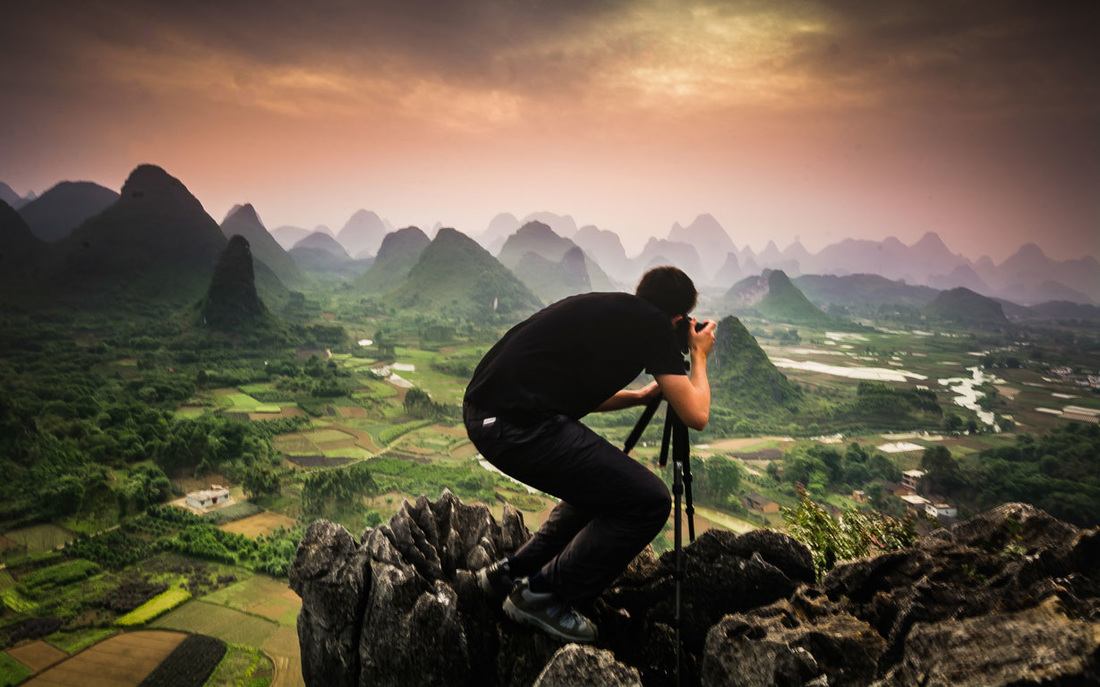How difficult are Guilin's mountains to climb?
Guilin is a beautiful and unique part of the world, but expect steps!
|
Just how difficult are Guilin's mountains to climb? How fit do you need to be? How steep are the paths up the rice terraces, and how long and arduous is the hike? Is it dangerous?
This article gives you a clear picture of how strenuous our photography locations are. We've hesitated in writing advice until now, because it is very challenging to convey since we're all different. Our Gatsby team who run wild Great Wall hiking, photography and camping find this topic the most challenging to address. Most of us think we're younger, fitter and more capable than we are.
On the one hand, my father is 74 and is skiing, yes skiing in the halfpipe. On the other hand, my good friend is 35, and his running induced knee problem means he takes an hour to hike up what most people do in 20 minutes. Everyone is so different. So this is a challenge... here goes...
|
How fit do you need to be?
All our clients have been able to handle the locations we have selected for them because all of our trips are totally bespoke. We design it for your precise dates, the season, your interests, and the style of your photography. We carefully consider which photography locations are best on your dates. So if you prefer to take it easy or have a knee/back problem (or other) just let us know. We'll factor your needs into the plan and work with you to create a tour that works for you.
Factors that Double the Height of Guilin's Peaks
These factors really do make Guilin's mountain much more difficult to climb than the no. of steps, altitude or distance would indicate.
Humidity and Heat
Temperatures of 78 to 97 Fahrenheit (26-36 Celsius) might not seem hot to Aussies and Californians, but add Guilin's high humidity and the mountains seem to double in height.
Honestly, on a humid day it can feel like you played an hour of squash... with a camera bag on your bag ;) Don't sweat! On the trip, we can adapt to your needs factoring in rest time during the hottest part of the day. On average 60-70% of clients take the chance to rest, download, backup data, shower and cool off at the hotel, just let us know. Our trips are flexible. Jetlag, Long Days, Early StartsIf you've arrived from a long-haul flight and suffer from jet lag, or have been traveling extensively, this all makes the top seem further.
|
Burden of Heavy Camera BagsYour camera equipment and tripod weight will also be a factor sapping your energy.
In some locations, we can arrange locals to act as your porter/sherpa (i.e. someone who helps carry bags). But...China is a lot more expensive than the neighbouring countries like Laos, Cambodia, Thailand, and Nepal, where a sherpa costs one or two dollars, in China it typically costs 15-20 dollars. They have a hard job, in that they need to wake at 4am or earlier to start walking up from their village to the mountain, meet us, carry the bag, wait a couple of hours (at least) and then carry the bag down again. So they earn their wage. However, during the hot summer months it is a choice to consider. We will do our best to help arrange a sherpa the day before at the mountain locations. |
Stairway to Heaven
Nearly all landscape photography locations have steps. The very best locations have many.
To put this in perspective, imagine putting your camera bag on your back and taking the stairs up a skyscraper in summer with no air conditioning. Even as someone who has run marathons, each year after the winter break my legs are back to square one. These are the kind of muscles I rarely use when running. Steps are in a league of their own but you can just take it easy and take a rest.
To put this in perspective, imagine putting your camera bag on your back and taking the stairs up a skyscraper in summer with no air conditioning. Even as someone who has run marathons, each year after the winter break my legs are back to square one. These are the kind of muscles I rarely use when running. Steps are in a league of their own but you can just take it easy and take a rest.
Specific Mountains Location Examples
Here are two specific examples of mountains we often take people to:
|
Mountain Location 1
PAIN: 500 steps straight up. These are good regular stone steps with a hand rail. Like climbing to the 18th floor in a tower block. Of course, we can rest and take our time. GAIN: A dramatic mountaintop view over a wonderful bend in the Li River, with layers of mountains running into the distance, with the sunrise behind. |
Mountain Location 2
PAIN: This is more of a hike, rather than only steps. Hiking on an ancient 3000-year-old mountain trail. It runs in the bamboo and trees and offers good shade, winding up gradually. There are some sections of the trail which have many steps. The route is a little uneven, and the ancient polished stone steps can be slippy. GAIN: A wonderful view of a wide sweeping bend in a rural part of the river from a more mid-level height. There are no roads, gates, tourists at all at this location. It makes an ideal place for doing stitching images (panorama). |
Dangerous Mountains
|
We sometimes take photographers to fairly dangerous locations, but they are for the most nimble, the most steady on their feet. These locations are for the very fit and agile.
A few people have come down the mountain and said never again, but still ecstatic they did it and got the shot. A ER doctor climbed one carefully and enjoyed the view, but advised us 'It's only a matter of time before someone slips and hits their head.' Others have thought it's a cool route and handled it in Teva's (sandals). (The location in the photo to the right now has steps and a viewing platform on the top, but it was like this for many years until 2017) |
In the wet or the dark coming down these locations become seriously dangerous. The uneven path and slippy clay mean a simple trip or slip risks a head injury, even though the path down has no great fall. The karst rocks can leave you with muddy clothes, tears in your clothes or a nasty purple bruise, or worse.
In the wet, we can't go up these locations. If you're on the mountain and our guide even faintly smells the rain, we need to leave fast. Please respect their advice; it's for your safety.
We take no liability and accept no responsibility if you wish to go up these locations. Off the beaten track has risks, travel has risks and setting a tripod up on these karst mountains and focusing on photography means accidents can happen.
In the wet, we can't go up these locations. If you're on the mountain and our guide even faintly smells the rain, we need to leave fast. Please respect their advice; it's for your safety.
We take no liability and accept no responsibility if you wish to go up these locations. Off the beaten track has risks, travel has risks and setting a tripod up on these karst mountains and focusing on photography means accidents can happen.
Guilin is Worth the Sweat!
Guilin is unlike any other place on earth, but it costs you sweat to capture it. It's not like many locations in the US where you can drive a car to a national park carpark and walk a short distance to capture a portfolio shot. The best photos of Guilin require you to hike and hit the steps. We need to wait for weather to change, rain to go, but know that... 'bad weather' is we have the most potential to take 'the best photos'!.



